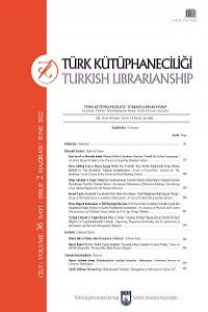Karma Kütüphane: Dijital ve Geleneksel Kütüphanelerin Odak Noktası
Günümüzde kütüphaneler geleneksel basılı dermelerden hem basılı hem de dijital kaynakları içeren “karma kütüphaneler”e dönüşmektedir. Bu aşamada karşılaşılan en temel sorun karma kütüphanelerin tanım, amaç ve görevlerinde ortak bir anlayış geliştirilmemiş olmasıdır. Modern kütüphanelerin iki türü olarak dijital ve karma kütüphaneler farklı şekillerde tanımlanmakta, ancak birçok ortak özellikler taşımaktadır. Bu makalede karma kütüphanelerin tanıtımı, özellikleri ve görevleri, dijital ve karma kütüphaneler arasındaki ilişkiler ve karma hizmetler incelenmektedir.
Anahtar Kelimeler:
Karma kütüphane, dijital kütüphane, geleneksel kütüphane
The Hybrid Library: The Focal Point of Traditional and Digital Libraries
Manylibraries are currently experiencing a transition from traditional printbased collections to one that holds a mix of print and digital resources. This has ledto the existence of so called hybrid libraries. A hybrid library conjugates elementsof the traditional and the digital library. The most basic challenge* Doktoraöğrencisi.Hacettepe Üniversitesi Bilgi ve BelgeYönetimi Bölümü. e-posta: afzali@hacettepe.edu.tris to acquire a common understanding of their defi nitions, aims, and missions. Digital and hybrid libraries are two kinds of modern libraries, defi ned as different entities. Defi nitions of these libraries show some overlap. So, it is not possible to separate them as two completely different types of libraries. The aim of this paper is to investigate the practices of and challenges confronting hybrid and digital libraries
Keywords:
Hybridlibrary, digital library, traditional library,
___
- Agora.(2003). 3 Ekim 2005 tarihinde http://hosted.ukoln.uk.ac/agora/scope.html
- Battin, P. (1984 Summer). The electronic library: a vision for the future. EDUCOM Bulletin, 19(2), 12-17, 34.
- Bakeri, A.,Bakar, A. ve Abdoulaye, K. (2002). Collection development for the digital age: The case of Malaysia. Lecture Notes in Computer Science içinde (cilt 2555, s. 366-378). Berlin: Springer-Verlag.
- Breaks, M. (2001). The eLib hybrid library projects. Ariadne, 28. 24 Ekim 2006 tarihinde http://www.ariadne.ac.uk/issue28/hybrid/intro.html adresinden erişildi.
- Breaks, M. (2002). Building the hybrid library: a review of UK activities. Learned Publishing(Association of Learned and Professional Society Publishers), 15(2): 99-107.
- Buckland,M. (1997). Redesigning library services: a manifesto. 10 Ekim 2006 tarihinde http://sunsite.berkeley.edu/Literature/Library/Redesigning.html adresinden erişildi.
- BUILDER.(2003). 14 Ekim 2006 tarihinde http://builder.bham.ac.uk/ adresinden erişildi.
- Cimbala, D. (1987). The scholarly information center: an organizational model. College & Research Libraries, 48, 393-398.
- Cleveland,G. (1998). Digital libraries: Definitions, issues and challenges. IFLA UDT Core Programme Occasional Paper. 20 Ekim 2006 tarihinde http:// www.ifla.org/VI/5/op/udtop8/udt-op8.pdf adresinden erişildi.
- Crawford, W. (1999). Being analog: creating tomorrow's libraries. Chicago: American Library Association.
- Deegan,M. ve Tanner, S. (2004). Ayendeye dijitaliyi ketabkhaneha (A. Gilvari, Çev.) [Digital futures: strategies for the information age]. Tahran: Debizeş, Çapar.
- Garrod, P. (1999). Survival strategics in the learning age: hybrid staff and hybrid libraries. Aslib Proceedings, 51(6): 187-194.
- Gopal,K. (2003). Kitabkhanehai dijital der asre etelaat elektroniki (A. Radbaveh, Çev.). [Digital library in electronic information era]. Tahran: Engineering Research Institute.
- Gregory,L. (2000).Technologies for the hybrid library. Serials Rewiew, 26(3): 80-82.
- Guy, R. (2000). Developing the hybrid library: progress to date in The National Library ofScotland, The Electronic Library, 18(1): 40-50.
- HEADLINE.(2003). 4 Ekim 2006 tarihinde http://www.headline.ac.uk/ adresinden erişildi.
- HyLiFe. (2003). 5 Ekim 2006 tarihinde http://www.unn.ac.uk/~xcu/hylife
- JISC.(1994). Circular 4/94 FIGIT Framework. Bristol: JISC, 1994. 20 Ekim 2006 tarihinde http://www.jisc.ac.uk/pub/c4_94.html adresinden erişildi.
- JISC.(1995). Circular 11/95 Electronics Library Programme (eLib): targeted call for new proposals. Bristol: JISC. 20 Ekim 2006 tarihinde http://www.jisc. ac.uk/pub/c11_95.htmladresinden erişildi.
- Karol, S. (2004). Biyoloji terimleri sözlüğü. Ankara: Türk Dil Kurumu.
- MALIBU.(2003). 17 Ekim 2006 tarihinde http://www.kclac.uk/humaities/cch/ malibu/adresinden erişildi.
- National Library of New Zealand. (2002). Briefi ng for the incoming minister National Library of New Zealand. 24 Nisan 2006 tarihinde http://www.natlib. govt.nz/files/1pubbim.pdf adresinden erişildi.
- Odlyzko,A. (1997). Silicon dreams and silicon bricks: continuing evolution of libraries. Library Trends, 46(1), 152-167.
- Oppenheim, C. ve Smithson, D. (1999). What is the hybrid library? Journal of Information Science, 25(2), 97-112.
- Pinfield S., Eaton, J., Edwards, C., Russell, R., Wissenburg, A. ve Wynne, P.(1998). Realizing the hybrid library. D-Lib Magazine, 4(9). 20 Ekim 2006 tarihinde http://www.dlib.org/dlib/october98/10pinfield.html adresinden erişildi.
- Raitt, D. (2000). Digital library initiatives across Europe. Mark Computers in Libraries, 20(10), 26-35.
- Robinson,K. (2001). The future is hybrid: libraries in the 21st century: a one day workshop. Ariadne, 26, 4 Ekim 2006 tarihinde http://www.ariadne.ac.uk/ issue26/kate-robinson/intro.htmladresinden erişildi.
- Rowlands, I. ve Bawden, D. (1999). Digital libraries: a conceptual framework. Libri, 49, 192-202.
- Rusbridge, C. (1998). Towards the hybrid library. D-Lib Magazine, 7(7/8). 14 Ekim 2006 tarihinde http://www.dlib.org/dlib/july98/rusbridge/07rusbridge. htmladresinden erişildi.
- Russell, R., Gardner, T. ve Miller, P. (1999). Models Information Architecture (MIA). Requirements analysis study of hybrid library environments. 25 Eylül 2006tarihinde http://www.ukoln.ac.uk/dlis/models/requirements/overview/ adresinden erişildi.
- Smithson, C.D. (1999). What is the hybrid library. Journal of Information Science, 25, 97- 112.
- Subaşıoğlu, F. (2001). Dijital kütüphaneler: tanımlama sorunu. Türk Kütüphaneciliği, 15,45-54.
- Suber, P. (2006). Nine questions for hybrid journal programs. SPARC Open AccessNewsletter, 101. 25 Aralık 2006 http://www.earlham.edu/~peters/fos/ newsletter/09-02-06.htmadresinden erişildi.
- Sutton, S.A. (1996). Future service models and the convergence of functions: the referencelibrarian as technician, author and consultant. K. Low (Ed.), The rolesof reference librarians: today and tomorrow içinde (s. 125-143). New York: The Haworth Press.
- Van House, N. ve Sutton, S. (1996). The Panda Syndrome: an ecology of LIS education. Journal of Education for Library and Information Science, 37, 131-147.
- Başlangıç: 1952
- Yayıncı: Türk Kütüphaneciler Derneği
Sayıdaki Diğer Makaleler
Cumhuriyet Dönemi Makaleler Bibliyografyası 1923-1999: Eleştirel Bir Değerlendirme
Türkiye'de Bilimsel Elektronik Dergiler
Umut AL, Mehmet Emin KÜÇÜK, N. Erol OLCAY
Türkiye’de Bilimsel Elektronik Dergiler
Mehmet Emin KÜÇÜK, Umut AL, N. Erol OLCAY
Karma Kütüphane: Dijital ve Geleneksel Kütüphanelerin Odak Noktası
Dergi Kullanım Verilerinin Bibliyometrik Analizi ve Koleksiyon Yönetiminde Kullanımı
Bilgi Yönetimi Bölümü Öğrencilerinin Öğrenme Stilleri
Serap KURBANOĞLU, Buket AKKOYUNLU
İlkçağ Anadolu Uygarlıklarında Sosyo-Ekonomik ve Kültürel Yapı Bağlamında Kütüphane/Arşiv Kurumu
